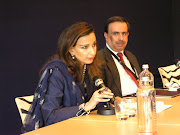Last week
many Indians celebrated Holi, the Hindu festival of colours, at its vibrant
best in India’s most populous, politically powerful and ungovernable state,
Uttar Pradesh (UP). Until 1977 every prime minister of India had been elected
from Uttar Pradesh, which occupies the subcontinent’s most fertile country,
between the two great rivers of the Indus and Ganges. With a population of 200 million
- nearly ten times that of Australia - UP just about ranks as a
country in its own right. A small town in Eastern UP, Mirzapur sets the time
for all of India; Indian Standard Time is calculated on the basis of the clock
tower in the centre of the town. And whoever “wins” UP has traditionally
determined power across independent India, with some notable exceptions.
Once
again in this fast-looming general election, UP is where the fate of the
general election may well be decided. Holi this year was therefore destined to
be more wild and boisterous than usual. Holi marks the arrival of spring after
winter, a period of renewal and fresh energy. It is the inspiration for the Colour Run – an event spruiked as the
world’s happiest five-kilometre run - where participants get plastered with
paint as they run. Among Hindus the tradition marks the victory of good over
evil and is also associated with the life of the young Lord Krishna.
Until
recently few major blockbusters of Bollywood could do without a Holi
song-and-dance routine. The most famous is one performed by India’s most
popular actor, Amitabh Bachchan, in the 1981 movie Silsala. Bachchan
used the song Rang Barse during the 1984 electoral campaign in his
hometown, UP’s Allahabad. It helped deliver him the Lok Sabha seat by one
of the highest margins in India’s electoral history. (Bachchan later resigned
in disgust, describing politics as a “cesspool”.)
Throughout
UP a particular local version of the tradition, the Lath Mar Holi, re-enacts
the “naughtiness” associated with the teenage Krishna who famously teased his
beloved Radha and her village friends, the Gopis. Today, men from Krishna’s
village Nandgaon visit Radha’s Barsana and are playfully “beaten” with sticks
(Laths) by the women from the village. Holi, in essence, is the great
equaliser, as all hierarchies break down and there is a new joie de vivre
and an affirmation of life in all its colours.
Eight
of India’s 16 prime ministers have come from UP and the state sends 80
representatives to the Lok Sabha – more than any other state in India.
Interestingly, UP was a creation of the British seeking to manipulate the
geography of India to serve their interests after the first Indian war of
Independence in 1857 - referred to by the Imperialists as the Great Indian
Mutiny. The new state was initially called the North Western Provinces of Agra
and Oudh, and in 1902 was renamed the United Provinces of Agra and
Oudh and popularly referred to as the United Provinces or
its acronym UP.
UP
became Uttar Pradesh, or the Northern State, after India’s independence. In
1999, the hilly parts of UP were carved into a new state of Uttarakhand. There
are continued demands for a further reorganisation of UP into new states in
what is administratively one of the most poorly governed regions of India.
UP is a
mirror of the complexities and contradictions of India. Religion and caste have
traditionally played an important role in electoral calculations. Until the
late 1970s, the Congress Party was able to translate the support of the
upper-caste Brahmins, Dalits at the bottom of the caste hierarchy and the
Muslim minority into an unbeatable electoral constituency. The Jat leader,
Chaudhuri Charan Singh (representing the middle peasantry) was the only
non-Congress chief minister until 1977.
The
1980s and 1990s saw this traditional caste and religious arithmetic collapse.
The Congress’s political influence in the state declined as castes became more
discreet kinship groups rather hierarchical steps in a social ladder. The
upper-caste Hindus, including the Brahmins, moved to the more nationalistic
Bharatiya Janata Party (BJP), believing that the Congress was appeasing the
Muslims. The Muslims themselves felt no longer protected under the Congress and
built a coalition with the intermediate castes, led by the Yadavs, and the new
Samajwadi Party. The Dalits' political awakening led to a revolt from the
Congress (they believed that the Congress had used them as a vote bank) and the
formation of the Bahajun Samaj Party.
2014
will witness at least a four-cornered contest in UP, with three prime
ministerial aspirants all contesting from the state - and that is only one of
the reasons it is so electorally unpredictable. Gujarat’s chief minister and
BJP’s prime ministerial candidate, Narendra Modi, will contest from Varanasi -
one of the holiest cities for the Hindus. The Common Man’s Party (Aam Admi
Party) leader, Arvind Kejriwal, has threatened to contest against Modi, while
Rahul Gandhi of the Congress will fight from his regular constituency, Amethi.
The
biggest opinion survey conducted so far by the television network NDTV suggests
that BJP will be the main gainer and could win half of UP’s parliamentary
seats. Indeed without winning at least 40 seats in UP, Modi’s prime ministerial
ambitions could come to nought. UP has produced eight prime ministers but it
has also been the slayer of many a prime ministerial ambition.
Traditionally,
on the day of Holi, bhang with thandai (a beverage of sweet cold milk mixed
with leaves and buds of the cannabis plant and topped with almond shavings) is
drunk in the morning to give you that heady festive feeling. But with elections
around the corner no bhang will be needed to raise spirits in Uttar Pradesh.
(Source: www. http://electionwatch.edu.au/india-2014/holi-holies-power)








